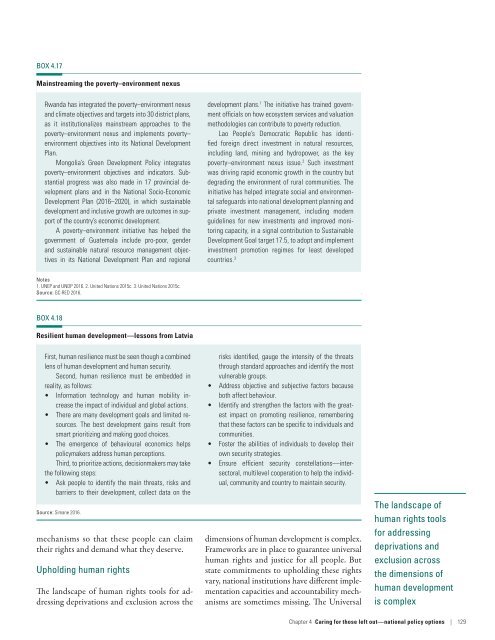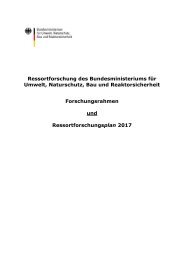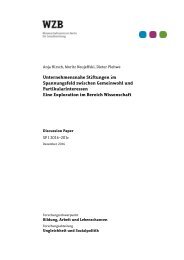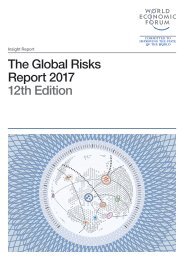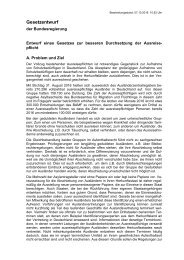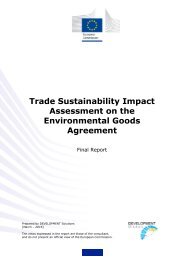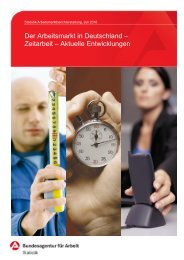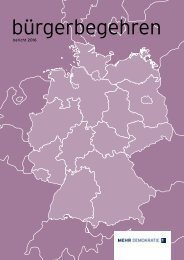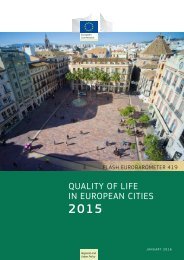Human Development Report 2016
6Tyccfrzw
6Tyccfrzw
Create successful ePaper yourself
Turn your PDF publications into a flip-book with our unique Google optimized e-Paper software.
BOX 4.17<br />
Mainstreaming the poverty– environment nexus<br />
Rwanda has integrated the poverty– environment nexus<br />
and climate objectives and targets into 30 district plans,<br />
as it institutionalizes mainstream approaches to the<br />
poverty– environment nexus and implements poverty–<br />
environment objectives into its National <strong>Development</strong><br />
Plan.<br />
Mongolia’s Green <strong>Development</strong> Policy integrates<br />
poverty– environment objectives and indicators. Substantial<br />
progress was also made in 17 provincial development<br />
plans and in the National Socio-Economic<br />
<strong>Development</strong> Plan (<strong>2016</strong>–2020), in which sustainable<br />
development and inclusive growth are outcomes in support<br />
of the country’s economic development.<br />
A poverty– environment initiative has helped the<br />
government of Guatemala include pro-poor, gender<br />
and sustainable natural resource management objectives<br />
in its National <strong>Development</strong> Plan and regional<br />
development plans. 1 The initiative has trained government<br />
officials on how ecosystem services and valuation<br />
methodologies can contribute to poverty reduction.<br />
Lao People’s Democratic Republic has identified<br />
foreign direct investment in natural resources,<br />
including land, mining and hydropower, as the key<br />
poverty– environment nexus issue. 2 Such investment<br />
was driving rapid economic growth in the country but<br />
degrading the environment of rural communities. The<br />
initiative has helped integrate social and environmental<br />
safeguards into national development planning and<br />
private investment management, including modern<br />
guidelines for new investments and improved monitoring<br />
capacity, in a signal contribution to Sustainable<br />
<strong>Development</strong> Goal target 17.5, to adopt and implement<br />
investment promotion regimes for least developed<br />
countries. 3<br />
Notes<br />
1. UNEP and UNDP <strong>2016</strong>. 2. United Nations 2015c. 3. United Nations 2015c.<br />
Source: GC-RED <strong>2016</strong>.<br />
BOX 4.18<br />
Resilient human development — lessons from Latvia<br />
First, human resilience must be seen though a combined<br />
lens of human development and human security.<br />
Second, human resilience must be embedded in<br />
reality, as follows:<br />
• Information technology and human mobility increase<br />
the impact of individual and global actions.<br />
• There are many development goals and limited resources.<br />
The best development gains result from<br />
smart prioritizing and making good choices.<br />
• The emergence of behavioural economics helps<br />
policymakers address human perceptions.<br />
Third, to prioritize actions, decisionmakers may take<br />
the following steps:<br />
• Ask people to identify the main threats, risks and<br />
barriers to their development, collect data on the<br />
Source: Simane <strong>2016</strong>.<br />
mechanisms so that these people can claim<br />
their rights and demand what they deserve.<br />
Upholding human rights<br />
The landscape of human rights tools for addressing<br />
deprivations and exclusion across the<br />
risks identified, gauge the intensity of the threats<br />
through standard approaches and identify the most<br />
vulnerable groups.<br />
• Address objective and subjective factors because<br />
both affect behaviour.<br />
• Identify and strengthen the factors with the greatest<br />
impact on promoting resilience, remembering<br />
that these factors can be specific to individuals and<br />
communities.<br />
• Foster the abilities of individuals to develop their<br />
own security strategies.<br />
• Ensure efficient security constellations — intersectoral,<br />
multilevel cooperation to help the individual,<br />
community and country to maintain security.<br />
dimensions of human development is complex.<br />
Frameworks are in place to guarantee universal<br />
human rights and justice for all people. But<br />
state commitments to upholding these rights<br />
vary, national institutions have different implementation<br />
capacities and accountability mechanisms<br />
are sometimes missing. The Universal<br />
The landscape of<br />
human rights tools<br />
for addressing<br />
deprivations and<br />
exclusion across<br />
the dimensions of<br />
human development<br />
is complex<br />
Chapter 4 Caring for those left out — national policy options | 129


